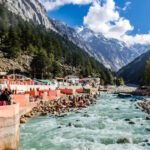Kedarnath Tour: The Sacred Abode of Lord Shiva in the Himalayas
Kedarnath, one of India’s most revered pilgrimage sites, is dedicated to Lord Shiva. Located in the Rudraprayag district of Uttarakhand, it stands as the highest among the twelve Jyotirlingas (sacred shrines of Lord Shiva). Kedarnath is also a significant part of the Char Dham Yatra, which includes Badrinath, Gangotri, and Yamunotri. Nestled at an altitude of 3,583 meters (11,755 feet) above sea level, Kedarnath is surrounded by the majestic, snow-capped peaks of the Garhwal Himalayas, making it a spiritually enriching and visually stunning destination.
Historical and Mythological Significance of Kedarnath
Kedarnath is steeped in ancient legends and myths, enhancing its spiritual allure. According to Hindu mythology, the temple was established by the Pandavas, the heroic brothers from the Mahabharata, as an act of repentance for their sins during the Kurukshetra war. Seeking forgiveness from Lord Shiva, the Pandavas journeyed to the Himalayas, but Lord Shiva, unwilling to absolve them so easily, disguised himself as a bull and hid among a herd in Kedarnath.
Upon recognizing Shiva in his disguise, the Pandavas witnessed him diving into the ground, with different body parts appearing at various locations. The hump of the bull emerged at Kedarnath, forming the conical lingam worshipped in the temple today. The remaining body parts surfaced at four different locations, creating the Panch Kedar pilgrimage circuit.
The Kedarnath Temple
The Kedarnath Temple is an architectural marvel, showcasing ancient Indian engineering and devotion. Constructed from large, heavy stones, it is believed to have been built by the Pandavas and later renovated by Adi Shankaracharya in the 8th century. The temple features a simple yet robust design with a tall, pyramidal tower and intricate carvings on its inner walls. Despite being situated in a region prone to extreme weather, the temple has endured numerous natural calamities, including the devastating floods of 2013.
Inside the temple, the sanctum sanctorum houses the conical Shiva lingam, worshipped as Lord Shiva in his Sadashiva form. The temple’s sanctity is elevated by its serene surroundings, with the Mandakini River flowing nearby and the towering Kedarnath peak in the backdrop.
The Kedarnath Trek
Reaching Kedarnath involves a trek that adds adventure and spiritual fulfillment to the pilgrimage. The trek starts from Gaurikund, the last motorable point, covering approximately 16 kilometers. The route takes you through lush forests, cascading waterfalls, and rocky terrain, offering breathtaking views of the Himalayan landscape. While the path is steep and challenging in parts, the determination of pilgrims of all ages reflects their unwavering faith in Lord Shiva.
With recent infrastructure developments, helicopter services are available from Phata, Guptkashi, and other nearby helipads, providing an alternative for those who cannot undertake the arduous trek. Additionally, ponies and palanquins can be hired to assist pilgrims in reaching the temple.
Best Time to plan Kedarnath Tour
The best time to plan Kedarnath tour is during the summer months, from May to June and September to October. These periods offer relatively pleasant weather, clear skies, and moderate temperatures, ideal for trekking. The temple opens its doors to devotees in late April or early May, coinciding with the festival of Akshaya Tritiya, and remains accessible until the festival of Kartik Purnima (usually in November). During the winter months, heavy snowfall causes the temple to close, and the idol of Lord Shiva is moved to the Omkareshwar Temple in Ukhimath for worship until spring.
Tips for Pilgrims planning Kedarnath Tour
– **Physical Preparation**: The trek to Kedarnath is challenging, especially for those unaccustomed to high-altitude trekking. Pilgrims are advised to undergo physical training and acclimatization before embarking on the journey.
– **Clothing and Gear**: Carry warm clothing, rain gear, and sturdy trekking shoes, as the weather in the Himalayas can be unpredictable, with sudden temperature drops and rainfall.
– **Accommodation**: Limited accommodation options are available in Kedarnath, including guesthouses, lodges, and tents. It’s advisable to book in advance, especially during the peak pilgrimage season.
– **Health Precautions**: Carry essential medicines and a first-aid kit. Staying hydrated and consuming nutritious food is crucial to maintaining energy levels during the trek.
– **Respect Local Customs**: Kedarnath is a sacred site, and pilgrims are expected to maintain decorum, dress modestly, and adhere to local customs and temple rules.
#### Conclusion
Embarking on a Kedarnath tour is not just a journey to a sacred site; it’s an enriching experience that intertwines adventure, spirituality, and stunning natural beauty. Whether you seek divine blessings or a connection with nature, Kedarnath promises an unforgettable pilgrimage.




